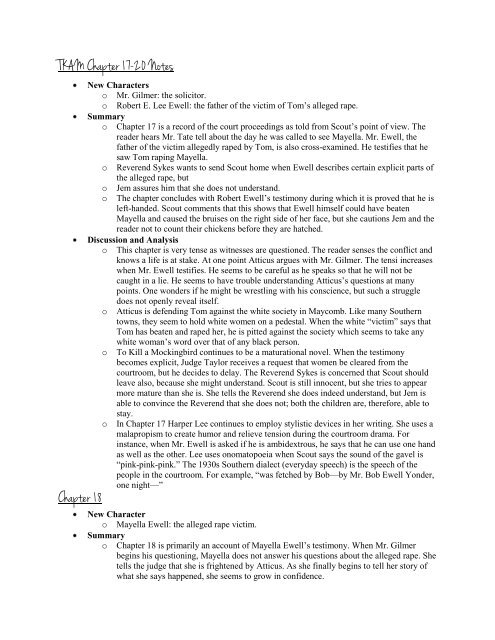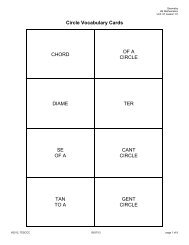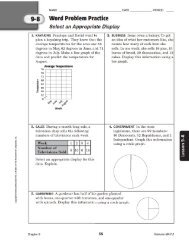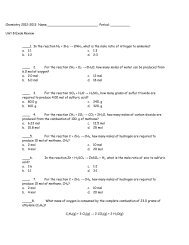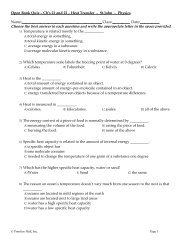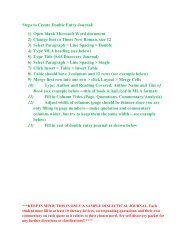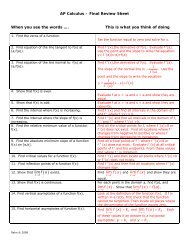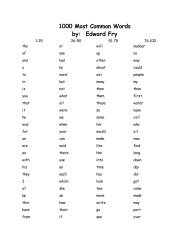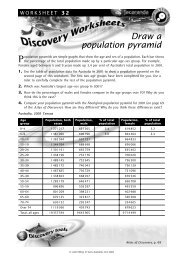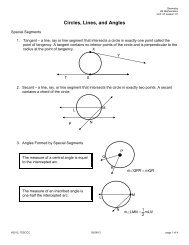You also want an ePaper? Increase the reach of your titles
YUMPU automatically turns print PDFs into web optimized ePapers that Google loves.
<strong>TKAM</strong> <strong>Chapter</strong> <strong>17</strong>-<strong>20</strong> <strong>Notes</strong><strong>Chapter</strong> <strong>18</strong>New Characterso Mr. Gilmer: the solicitor.o Robert E. Lee Ewell: the father of the victim of Tom’s alleged rape.Summaryo <strong>Chapter</strong> <strong>17</strong> is a record of the court proceedings as told from Scout’s point of view. Thereader hears Mr. Tate tell about the day he was called to see Mayella. Mr. Ewell, thefather of the victim allegedly raped by Tom, is also cross-examined. He testifies that hesaw Tom raping Mayella.o Reverend Sykes wants to send Scout home when Ewell describes certain explicit parts ofthe alleged rape, buto Jem assures him that she does not understand.o The chapter concludes with Robert Ewell’s testimony during which it is proved that he isleft-handed. Scout comments that this shows that Ewell himself could have beatenMayella and caused the bruises on the right side of her face, but she cautions Jem and thereader not to count their chickens before they are hatched.Discussion and Analysiso This chapter is very tense as witnesses are questioned. The reader senses the conflict andknows a life is at stake. At one point Atticus argues with Mr. Gilmer. The tensi increaseswhen Mr. Ewell testifies. He seems to be careful as he speaks so that he will not becaught in a lie. He seems to have trouble understanding Atticus’s questions at manypoints. One wonders if he might be wrestling with his conscience, but such a struggledoes not openly reveal itself.o Atticus is defending Tom against the white society in Maycomb. Like many Southerntowns, they seem to hold white women on a pedestal. When the white “victim” says thatTom has beaten and raped her, he is pitted against the society which seems to take anywhite woman’s word over that of any black person.o To Kill a Mockingbird continues to be a maturational novel. When the testimonybecomes explicit, Judge Taylor receives a request that women be cleared from thecourtroom, but he decides to delay. The Reverend Sykes is concerned that Scout shouldleave also, because she might understand. Scout is still innocent, but she tries to appearmore mature than she is. She tells the Reverend she does indeed understand, but Jem isable to convince the Reverend that she does not; both the children are, therefore, able tostay.o In <strong>Chapter</strong> <strong>17</strong> Harper Lee continues to employ stylistic devices in her writing. She uses amalapropism to create humor and relieve tension during the courtroom drama. Forinstance, when Mr. Ewell is asked if he is ambidextrous, he says that he can use one handas well as the other. Lee uses onomatopoeia when Scout says the sound of the gavel is“pink-pink-pink.” The 1930s Southern dialect (everyday speech) is the speech of thepeople in the courtroom. For example, “was fetched by Bob—by Mr. Bob Ewell Yonder,one night—”New Charactero Mayella Ewell: the alleged rape victim.Summaryo <strong>Chapter</strong> <strong>18</strong> is primarily an account of Mayella Ewell’s testimony. When Mr. Gilmerbegins his questioning, Mayella does not answer his questions about the alleged rape. Shetells the judge that she is frightened by Atticus. As she finally begins to tell her story ofwhat she says happened, she seems to grow in confidence.
<strong>Chapter</strong> 19o When Atticus begins his cross-examination, he is patient and calm with Mayella. Mayellaadmits that her father “does tollable” except when he has been drinking. She contradictsthis statement by saying that he has never touched a hair on her head. Mayella says shedoes not know how Tom did it, but he did take advantage of her. Atticus has Tom standand asks Mayella to identify him. It is then that the full court can see that Tom has a badarm.o Atticus concludes his questioning by asking Mayella if Tom or Mr. Ewell was the onewho beat her. He asks what Mr. Ewell really saw in the window. Mayella does notanswer. Finally Mayella says she has something to add. Her final words are, “That niggeryonder took advantage of me an’ if you fine fancy gentlemen don’t wanta do nothin’about it then you’re all yellow stinkin’ cowards, the lot of you.”o Atticus says that he has one more witness and the chapter concludes.Discussion and Analysiso Mayella’s testimony is as tense as her father’s was. Mayella seems to see Atticus as heraccuser. She claims fear of him in the court.o Mayella tries to testify in a convincing manner. It seems evident to the reader that attimes Mayella seems to want to tell the truth, but she struggles to keep to her story. Forinstance, she admits that her father is “tollable” except when he drinks, but she will notadmit that he beats her.o The Ewell family does not really fit into Maycomb society. Mayella is conscious of herlower class background. She feels others are better than she and that they are laughing ather. She is very insecure.o Mayella also brings racial conflicts into her testimony. She concludes by saying that“That nigger yonder” raped her and that the jury is a bunch of cowards if they do not findhim guilty. She is making the conflict white against blacks, rather than truth againstfalsehood.o In <strong>Chapter</strong> <strong>18</strong> Harper Lee depicts faithfully Mayella’s Southern dialect. For instance, shesays, “He does tollable. . . .”o The chapter ends as a cliffhanger; the reader must read on to hear Tom’s testimony.New Charactero Link Deas: the former employer of Tom Robinson.Summaryo <strong>Chapter</strong> 19 tells of Tom’s examination and a part of his cross-examination. During theexamination by Atticus, Tom tells how he helped Mayella on several occasions. He tells howMayella hugged him about the waist on the day in question, how Mr. Ewell appeared on thescene, and how Tom ran in fear.o At that point Link Deas stands up and announces, “I just want the whole lot of you to knowone thing right now. That boy’s worked for me eight years an’ I ain’t had a speck o’troubleouta him. Not a speck.” The judge tells Deas to shut up and throws him out of court.o Mr. Gilmer cross-examines Tom. During the questioning Tom says that he helped Mayellabecause he felt sorry for her. Scout believes these words are a mistake. Mr. Gilmer calls Tom“boy” each time he addresses him. Suddenly Dill begins to cry and Scout leaves with him.Outside the courtroom they see Mr. Deas. Dill tries to explain that things do not seem right inthe courtroom. Mr. Raymond, who is also waiting outside the courtroom, overhears Dill andapproaches to talk with the children.Discussion and Analysiso Tom’s testimony and cross-examination is difficult on many levels. Mr. Gilmer adopts an airof hostility against Tom to capitalize on the prejudice already felt against him. This hostilityis so strong that even Dill, who probably does not understand its source, can sense it. He
ooooo<strong>Chapter</strong> <strong>20</strong>breaks into tears and must be taken from the courtroom. In the face of this hostility, Tomattempts to restrain himself and answer the questions properly.Clearly, Tom seems pitted against many members of the white society as he attempts torespond from the witness stand. Reference is made also to the fact that Mayella is a part ofthe society that others in Maycomb frown upon. Tom mentions that he feels sorry for her andScout also makes reference to the fact that Mayella is a member of the lower class and hasfew friends.The mockingbird theme is very evident in <strong>Chapter</strong> 19. Tom has not harmed anyone. Althoughhe was being helpful, he has been treated cruelly.Examples of Tom Robinson’s dialect (everyday speech) abound in the courtroominterrogation. “She says she never kissed a grown man before an’ she might as well kiss anigger. She says what her papa do to her don’t count.” Gilmer’s dialect is also evident as hecalls Tom “boy” and causes Dill to be sick by his treatment of Tom.Lee makes use of many stylistic devices to tell her story. For example, Scout employsrepetition when she says what Miss Maudie has said earlier about Atticus: “He’s the same inthe courtroom as he is on the public streets.” Harper Lee uses irony subtly when Mayella andBob Ewell accuse Tom of lusting after a white woman when the reverse is actually true.Bravery versus cowardice is evident as Atticus and Tom continue to battle for truth and righteven though the conclusion seems to be foregone. There is only one reference to Boo Radleyand the motif of ghosts and superstitions: a comparison is made between the loneliness ofMayella and that of Arthur. This important theme in Part One has been replaced in Part Two.Summaryo After visiting with Raymond and finding out that he makes himself out “badder’n” he isalready, Dill and Scout rush back into the courthouse. They find that Atticus is finishing uphis summary. Atticus talks to the jury as if he were talking to an individual, concluding withthe statement, “In the name of God, believe him.”o Just as he finishes, Calpurnia makes her way down the center aisle of the courtroom.Discussion and Analysiso In this chapter we see a side of human nature which lies below the social codes that peopleare taught. No matter what role people play in society, they are probably similar underneath.Perhaps the rules of society were set up initially to hide these feelings. Atticus reminds theentire courtroom of the evil side of human nature which everyone faces: the tendency to lie,to do immoral things, and to look with desire on others.o Atticus tries to appeal to the humanity and morality of the jury when he reminds them to doits duty and return Tom Robinson to his home. The jury has a difficult decision to make.Many are fighting their consciences as they determine to convict Tom.o Society in Maycomb involves a caste/racial bias; this bias is evident in the “assumption—theevil assumption—that all Negroes lie. . . .” There is a sex bias in the society of Maycomb;most people in the South put the women on a pedestal. Mayella goes against the expectationsof society with her actions. “She did something that in our society is unspeakable: she kisseda black man.”o Another example of character-against-society occurs when certain persons try to get ahead.Getting ahead is difficult for them; they have to battle society. Others are able to get aheadmore easily. “Some people have more opportunity because they’re born with it. . . .” All typesof conflict are evident in <strong>Chapter</strong> <strong>20</strong>.o In <strong>Chapter</strong> <strong>20</strong> Atticus uses a statement that he used before; this is an example of repetition.He tells the court that his pity for Mayella does not “extend so far as to her putting a man’slife at stake, which she has done in an effort to get rid of her own guilt. . . .”
oooThe theme of education is brought out by Atticus in his summation. He says on page <strong>20</strong>5 thatthe most ridiculous example I can think of is that the people who run public educationpromote the stupid and idle along with the industrious—because all men are created equal,educators will gravely tell you, the children left behind suffer terrible feelings of inferiority.Mr. Raymond also gives the children a lesson when he says, “Cry about the simple hellpeople give other people—without even thinking.”Bravery versus cowardice (a secondary theme) is evident in this chapter as Atticus continuesto work toward a goal that he knows is unachievable; according to his definition, he himselfis the epitome of true bravery.


